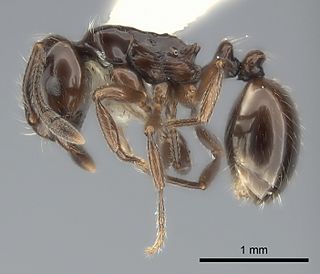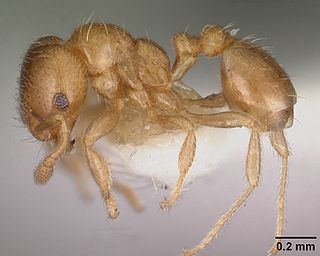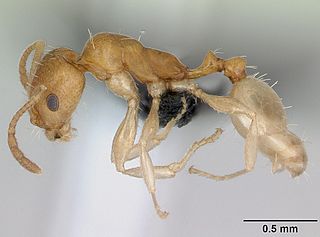
Myrmicinae is a subfamily of ants, with about 140 extant genera; their distribution is cosmopolitan. The pupae lack cocoons. Some species retain a functional sting. The petioles of Myrmicinae consist of two nodes. The nests are permanent and in soil, rotting wood, under stones, or in trees.

Gustav L. Mayr was an Austrian entomologist and professor in Budapest and Vienna. He specialised in Hymenoptera, being particularly known for his studies of ants.

Monomorium bidentatum is a species of ant in the subfamily Myrmicinae. It is endemic to two South American countries, Chile and Argentina.

Megalomyrmex is a genus of ant in the subfamily Myrmicinae. The genus is known only from the Neotropics, where some of the species are specialized parasites or predators of Attini.

Monomorium is a genus of ants in the subfamily Myrmicinae. As of 2013 it contains about 396 species. It is distributed around the world, with many species native to the Old World tropics. It is considered to be "one of the more important groups of ants," considering its widespread distribution, its diversity, and its variety of morphological and biological characteristics. It also includes several familiar pest species, such as the pharaoh ant and the flower ant.

Crematogastrini is a tribe of myrmicine ants with 64 genera and 8 fossil genera.

Solenopsidini is a tribe of myrmicine ants with about 20 genera.
Monomorium denticulatum is a species of ant in the subfamily Myrmicinae. It known from Chile and Argentina. Like M. bidentatum it was first described from Valdivia, Chile.

Bondroitia is a small genus of ants in the subfamily Myrmicinae. Its two species are from Africa.

Diplomorium is a genus of ants in the subfamily Myrmicinae containing the single species Diplomorium longipenne. The genus is known only from females and workers from South Africa, males remain unknown. Little is known about their biology, except that they nest under stones. They have been found nesting at the same location as Messor capensis, however, it is not known whether this was coincidence or if the species have a relation with each other.

Trichomyrmex destructor is a species of ant in the subfamily Myrmicinae. Its common names include destructive trailing ant or Singapore ant. It is a pest species in urban areas, known for causing costly damage to structures, vehicles, and electronic devices with its chewing activity. In 2015, the species was moved from the genus Monomorium to the revised genus Trichomyrmex.

Royidris is a Malagasy genus of ants in the subfamily Myrmicinae. Described in 2014, the genus contains 15 species endemic to Madagascar.

Trichomyrmex is a genus of ants in the subfamily Myrmicinae. Described by Mayr in 1865, it was raised as a genus in 2015. These ants are endemic to multiple continents.

Epelysidris brocha is the only species of ant in the genus Epelysidris. Described by Barry Bolton in 1987 in Borneo, the species is only known from soil in tropical and moss rainforests, based on two known specimen collections.
Trichomyrmex rogeri is a species of ant in the subfamily Myrmicinae. It is found in Sri Lanka. Gustav Mayr described the species in 1865.
In ecology, a tramp species is an organism that has been spread globally by human activities. The term was coined by William Morton Wheeler in the bulletin of the American museum of natural history in 1906, used to describe ants that “have made their way as well known tramps or stow-aways[sic] to many islands The term has since widened to include non-ant organisms, but remains most popular in myrmecology. Tramp species have been noted in multiple phyla spanning both animal and plant kingdoms, including but not limited to arthropods, mollusca, bryophytes, and pteridophytes. The term "tramp species" was popularized and given a more set definition by Luc Passera in his chapter of David F William's 1994 book Exotic Ants: Biology, Impact, And Control Of Introduced Species.











